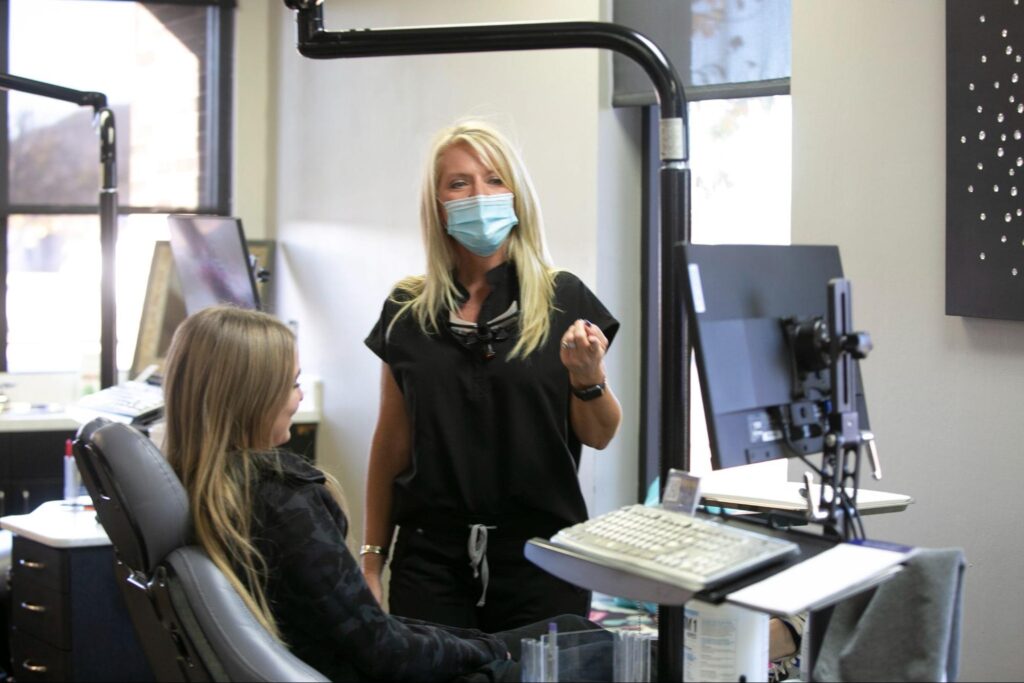One of the first things on your mind when thinking about orthodontic treatment is probably, How long will this take? The truth is, it depends. Every smile is different, and so is every treatment plan. Some people are done in a year, while others need closer to three.
If you’re considering orthodontic treatment in Oklahoma City, Edmond, or Clinton, knowing what affects your timeline can help you feel more prepared. It’s helpful to know what to expect, and when you choose Farrow & Dewbre Orthodontics, Dr. Farrow and Dr. Dewbre can make sure you are prepared.
What Affects How Long You’ll Be in Treatment?
Some people need just a little fine-tuning, while others require more involved treatment to correct alignment and bite issues. Several factors play a role in how long you’ll be wearing braces or aligners:
- Your age: Younger patients often see faster results because their teeth and jaws are still developing. Adults can absolutely achieve great results, too, but movement tends to take a little longer.
- Severity of your case: Minor crowding or spacing can be corrected more quickly, while bite issues or significant misalignment require a longer timeline.
- Type of treatment: Traditional braces, clear braces, and Invisalign all work at different speeds. Some methods are faster for certain issues, while others take more time to achieve the best results.
- Consistency with appointments and care: Following your orthodontist’s instructions, keeping up with regular check-ins, and practicing good oral hygiene help keep things on track.
A lot of it comes down to patience. Orthodontic treatment is a process, but one that delivers long-term results.
Treatment Timelines Based on the Type of Braces or Aligners
Not all orthodontic options work at the same pace. Here’s how long each one typically takes.
Metal Braces
Metal braces are the most common option for correcting alignment, bite issues, and spacing concerns. Brackets and wires apply pressure to gradually move your teeth into position.
Typical timeline: 18 to 36 months
The length of time depends on how much correction is needed. Some patients only need minor adjustments, while others require more complex shifts that take longer to perfect.
Clear Braces
Clear braces work the same way as metal braces but use tooth-colored or ceramic brackets for a more discreet look.
Typical timeline: 18 to 36 months
Because ceramic brackets are slightly more fragile than metal, adjustments may need to be made more carefully, which can sometimes extend treatment time. Otherwise, the timeline is very similar to traditional braces.
Invisalign
Instead of brackets and wires, Invisalign uses clear aligners to straighten teeth gradually. The aligners are removable, making them a popular choice for people who want more flexibility.
Typical timeline: 12 to 24 months
Invisalign works best when worn for at least 22 hours a day. Skipping wear time or not switching trays as directed can add extra months to treatment.
How to Keep Treatment Moving on Schedule
Some things, like age and severity of misalignment, are out of your control. But there are steps you can take to help keep your treatment on track.
- Wear your aligners or rubber bands as instructed: If your orthodontist gives you rubber bands or clear aligners, following directions exactly helps ensure the best results in the shortest time.
- Practice good oral hygiene: Brushing and flossing regularly prevent cavities and gum issues that could cause delays.
- Keep up with appointments: Adjustments are an essential part of the process. Missing check-ins or postponing appointments can slow things down.
- Avoid damaging your braces: Biting on hard foods or chewing on objects like pens can break brackets, leading to setbacks.
Sticking to the plan makes a difference. The more consistent you are, the sooner you’ll reach the finish line.
The Final Step is Typically Retainers and Long-Term Results
Once braces come off or the last Invisalign tray is done, retainers help keep everything in place. Without them, teeth can slowly shift back to their original positions.
Some retainers are removable, while others are bonded behind the teeth for a more permanent hold. Our team will recommend the best option based on your treatment plan. Wearing your retainer as instructed helps protect the time and effort you’ve invested.
Where to Get Started
Dr. Farrow and Dr. Dewbre take the time to create personalized treatment plans that fit each patient’s needs. Whether you’re considering braces or Invisalign, the first step is a consultation to go over your options.
Farrow & Dewbre Orthodontics offers treatment in Oklahoma City, Edmond, and Clinton. If you’re ready to find out what the process will look like for you, schedule an appointment to get started.


